AESTHETIC DENTISTRY
Rediscover your smile thanks to invisible dentistry
Aesthetic dentistry deals with dental aesthetics, both in the anterior and posterior regions.
The harmony of the smile is the concept that best expresses the aesthetics of the teeth, involving not only the teeth themselves (shape and colour) but also the conformation of soft tissues (gums) and the position of the elements.
What makes a smile beautiful and harmonious is often the combination of all these factors, also in relation to other facial characteristics.
An «imperfect» smile doesn't necessarily need to be changed; sometimes, a few simple procedures can improve it, identifying which factors to work on.
Dental cosmetics: simple procedures to improve a smile
Case 1: A simple case of agenesis (missing) of the lateral teeth: the patient was unhappy with her smile but did not want to undergo any invasive procedures. In this case, the concepts of "additive" dentistry were applied, allowing us to "transform" the canine teeth into lateral teeth, the left premolar into a canine, and give more importance to the central teeth, simply by adding the missing material, based on a diagnostic plan decided together with the patient. Two chairside sessions were sufficient to achieve the result.




Case 2: Another case resolved without any sacrifice of healthy dental tissue. The patient underwent at-home teeth whitening, and afterwards, the old restorations were simply removed, and the proportions between the elements were adjusted. The patient was satisfied with the final result, achieved in a few sessions, without resorting to any complex prosthetic therapy. The smile has "imperfections" but reflects what the patient desired.
Tissue preservation is always the most reliable procedure to obtain and maintain excellent long-term results. This concept pairs well with the term «invisible dentistry,» which is dear to us. The final result should not only be pleasant and harmonious but also invisible to the human eye.
No one would like to know that those close to us think our teeth are beautiful, but they look «fake».
Would anyone really need a veneer?




Case 3: Another case solved without the use of any prostheses but simply through a diagnostic wax-up performed in the laboratory, which guided us in the direct reconstruction of these elements. Already from the case analysis, it was clear that there was healthy dental tissue under the old restorations. What made them unacceptable were the shape and colour. Once the reconstructions were removed, and guided by our diagnostic plan, we proceeded with the reconstruction using nano-hybrid composite materials, directly at the chairside.
So, the first step is to study the patient's aesthetics to define their strengths and weaknesses. Treatment will focus on the latter, while the former, if possible, will be further highlighted, always in agreement with the patient's opinion.
Teeth whitening


Case 4: Another case of simple correction: the patient was not satisfied with the colour of her teeth and the surface of the enamel, which appeared altered. In the first phase, the patient underwent at-home whitening of the upper arch. In the photo on the right, the difference between the upper and lower arches can be noticed (lower teeth whitening will be performed later).


An operational phase and the final result, immediately after the enamel correction session. The chromatic difference between the upper and lower arches, where at-home whitening was not performed, is even more evident. In this way, the effectiveness of this type of treatment can be observed!
Application of dental veneers and inlays
Continuing this overview of aesthetic dentistry, we may have cases where the use of prosthetic veneers in ceramic or composite material is indicated, associated or not with inlays or crowns on the posterior sectors. This becomes necessary when there is significant missing dental tissue, or when the colour or height (vertical dimension) of the teeth needs substantial modification.


Case 5: M.'s case required the use of ceramic veneers and direct composite restorations on the lateral teeth and lower incisors. In this case too, the intervention was additive, without unnecessary demolition of healthy tissue. This same type of intervention can also involve the posterior teeth, as shown in the examples below.
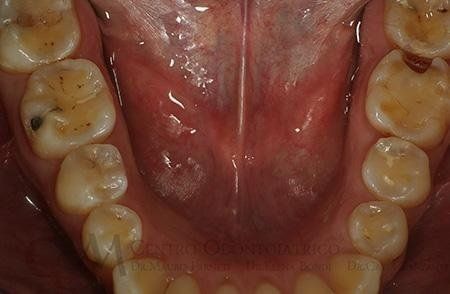
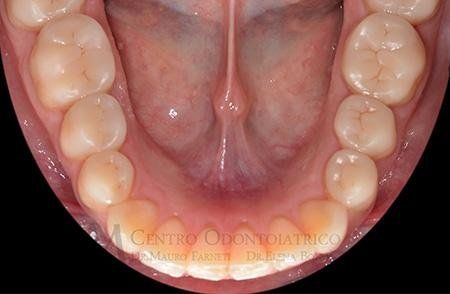
Case 6: In S., there was significant erosion of the enamel-dentin surface of most of the posterior teeth, which was restored using occlusal inlays.


Case 7: Another case, similar to the previous one, in which composite inlays were applied to the posterior teeth of patient G. to increase the worn vertical dimension. In this case too, all teeth were left alive and vital!
Single tooth posterior inlay on devitalised tooth
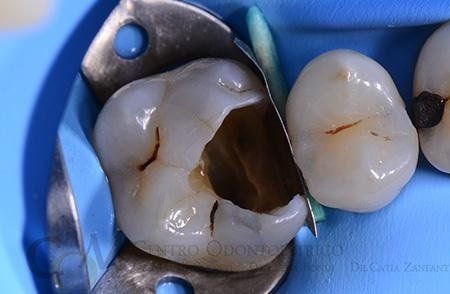
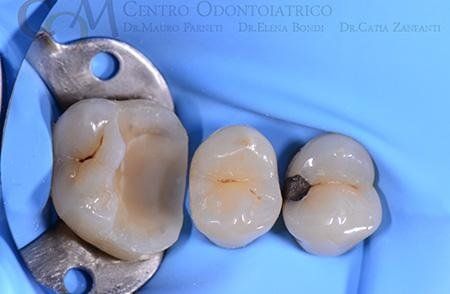
Case 8: The preoperative and reconstructive phases, before the insertion of the inlay (photos 1 and 2).
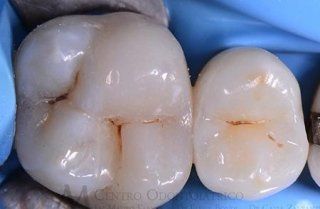
The inlay immediately after cementation and polishing. Due to the preservation of dental tissue, even though the element has been devitalised, it has excellent long-term retention prospects.
Gum recessions
Aesthetic concerns involve not only dental tissues but also gum tissues: deep recession can be equally unaesthetic, in addition to causing dentinal sensitivity.
This is the case of a lower incisor, associated with hypersensitivity of the collar, preventing proper oral hygiene manoeuvres in this area.
In cases like these, minimally invasive techniques of periodontal plastic surgery are capable of reforming the deeply altered tissue, recreating gum tissue, as shown in the next image.


Case 9: Before the intervention Case 9a: After the periodontal plastic surgery intervention.
Dental implants



In the cases that follow, we will have to correct increasingly severe defects, both in terms of teeth and soft tissues.
We start with a single implant, in a position of high aesthetic importance.
Case 10: Our patient's request was to conceal the exposed and darkened root portion of the upper right incisor and to improve the aesthetics of the left one, especially in reference to the soft tissues. This was compounded by severe defects in the bone support of these elements. In particular, the left incisor presented a loss of well over 50% of bone support.
This defect led to the forced extrusion of the left incisor, through orthodontic forces, to bring the gingival margin level closer to a position more similar to the adjacent teeth. The non-maintainable element was then replaced by implant insertion. All this only after eliminating all the periodontal pathology affecting the entire mouth, a condition absolutely necessary for implant treatment.
10a The care of our patient resulted, as a final act, in the application of prosthetic crowns with a zirconia oxide structure on both incisors.
10b In this image, you can see how the architecture of the soft tissues has been corrected, and the desired aesthetic criteria have also been achieved.
Looking at the two subsequent cases: teeth lost in areas of very high aesthetic and phonetic value. In both cases, a dental implant was inserted, simultaneously with the extraction of the irreparably compromised tooth, and immediate loading was performed by applying a resin prosthetic element on the same day. After the necessary time for complete integration of the implant, the definitive ceramic crown on zirconia oxide structure was applied.
Case 11: S. presented to the clinic with a fracture of the left central incisor. The root of the tooth was also severely compromised, and, in agreement with the patient, the implant solution was chosen.


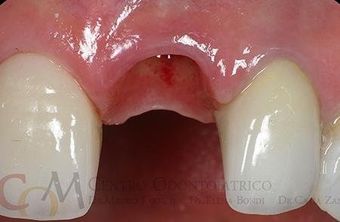
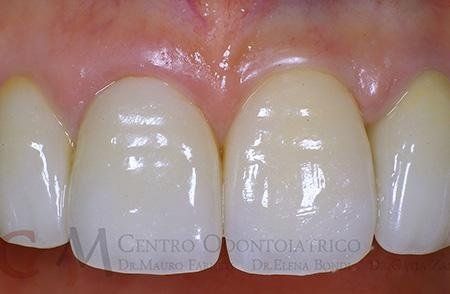

11a The case after the application of the definitive crowns. The patient is very satisfied. The photos show the case 6 years after loading: the gingival margins around the prosthetic crowns have maintained position and shape, aesthetically overlapping with the natural elements; this is thanks to perfect oral health, the result of a regular hygiene maintenance programme organised by our clinic and followed by our patients.



Case 12: Similar to the previous one, the replacement of a left upper canine by implant. In the left image, you can see the excellent integration of the ceramic crown with the adjacent natural teeth.


Case 13: Absence of the upper right first premolar and presence of a stump in the position of the second premolar, not maintainable.
13a: The implants placed.
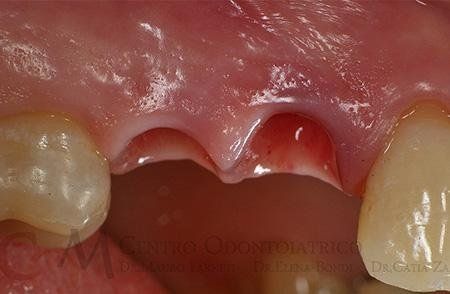
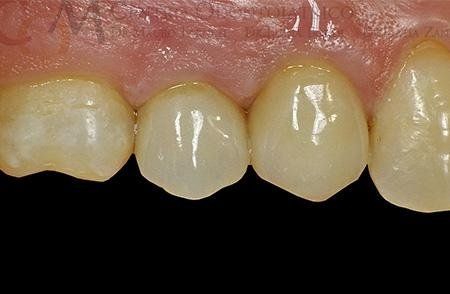
13b Proper management of soft tissues allows for the restoration of the interdental papilla, better defined as the interimplant papilla, which is the architecture of the soft tissues that will allow the crowns on the implants to have an absolutely natural appearance.
13c: Note the naturalness of the implant prosthetic elements.


Case 14: In the proposed case, it was necessary to restore a physiological harmony of the gingival margins of all upper incisors, along with giving the prosthetic elements a natural shape and colour. The patient was treated by our clinic, first resolving the state of chronic periodontal inflammation, and only then applying prosthetic devices with ceramic covering, on a zirconia oxide structure. The patient's collaboration in adhering to our maintenance programme has allowed us to maintain the result at the level of the control image after 13 years from the end of treatment.
14a The case of a 13-year follow-up.
In the image that follows, we notice an aesthetic problem due to an upward movement of the gingival margin of the two premolar teeth, with a thinning of the gingival tissue itself: the application of microsurgical periodontal plastic surgery techniques allows us to restore the gingival tissue to its natural size, covering the exposed and darkened root portion, without having to modify the existing prosthetic crown.


The smile you love is achieved by caring for, with passion,
the people who entrust us with their trust!

Certainly, achieving a "beautiful smile" is undoubtedly the result of the application of correct reconstructive techniques, both on dental and gingival tissues; it is undoubtedly linked to the collaboration of the dental team in the clinic: operators, hygienists, assisting personnel, dental laboratory; it is certainly based on the careful interpretation and respect of the needs of our patients, ultimately achieved by treating the people who entrust us with their trust in the most professional and passionate way possible.
Contact our aesthetic dentistry centre for more details.





